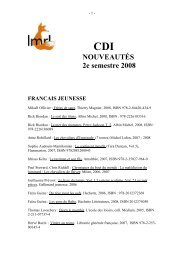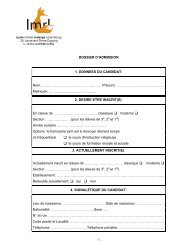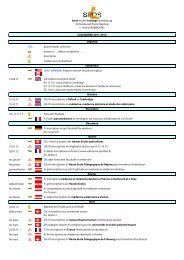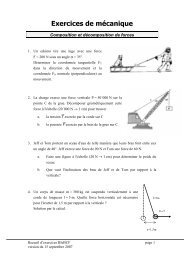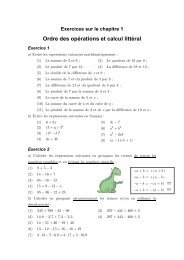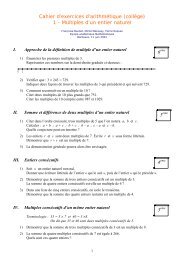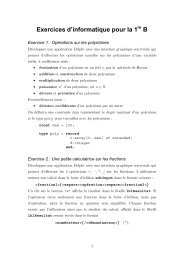You also want an ePaper? Increase the reach of your titles
YUMPU automatically turns print PDFs into web optimized ePapers that Google loves.
I re C, D – math I – <strong>Les</strong> <strong>nombres</strong> <strong>complexes</strong><br />
Exercice 26<br />
Effectuez les divisions suivantes (utilisez le schéma général et vérifiez par le schéma de<br />
Horner si possible) :<br />
( z 3 − 3iz 2 + 1− i z + 5) ÷ ( z 2 − z + 3)<br />
1) ( )<br />
( 3x 3 + 6i − 9 x 2 − 5ix + 10 + 15i ) ÷ ( x − 3+<br />
2i)<br />
2) ( )<br />
( 5 − i z 3 + 4iz + 9 − i) ÷ ( z 2 − 5)<br />
3) ( )<br />
2<br />
4) ( z − 2iz + 5 − i) ÷ ( z + i)<br />
( z + 3− 3i z + 3− 7i z + 14 − 8i) ÷ ( z + 3 − i)<br />
5) 3 ( ) 2<br />
( )<br />
Exercice 27<br />
4 3<br />
Pour quelles valeurs du paramètre m le polynôme ( )<br />
divisible par z − 2i ?<br />
Exercice 28<br />
Résolvez les équations suivantes :<br />
P(z) = z − 2iz + i − m z + 2m est-il<br />
1)<br />
2)<br />
3 2<br />
2z − (21+ i)z + (68 + 2i)z − 64 + 8i = 0 sachant qu’elle a une racine réelle.<br />
3 2<br />
z + (7 + 10i)z + (120i − 81)z + 110i − 407 = 0 sachant qu’elle a une racine<br />
réelle.<br />
3)<br />
3 2<br />
z + (8i − 9)z − (5 + 42i)z + 45 + 30i = 0 sachant qu’elle a une racine<br />
imaginaire pure.<br />
4)<br />
3 2<br />
2z + (5 −11i)z − (16 + 18i)z − 16 + 4i = 0 sachant qu’elle a une racine<br />
imaginaire pure.<br />
5)<br />
3 2<br />
z + 4(1 − i)z − 2(2 + 7i)z − 16 + 8i = 0 sachant qu’elle a une racine réelle.<br />
6)<br />
Exercice 29<br />
3 2<br />
z + 2z + 7iz − 5 − i = 0 sachant qu’elle admet une racine imaginaire pure.<br />
Factorisez le polynôme<br />
4 3 2<br />
P(z) = z + 4z + 8z + 4z + 7 sachant qu’il admet deux racines<br />
imaginaires pures.<br />
- 32 -



